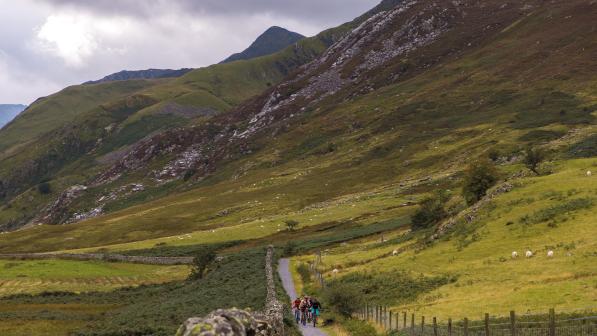Getting justice for cycle theft

When I saw the masked man checking out a second row of bikes I knew something was up. A theft was imminent, I thought, and it was my duty to do something about it.
I’d noticed the same man a little earlier that evening while I’d been running laps around a local park. He’d been leaning against a bench, staring at the bicycles locked up outside a swimming pool. On each of my first three circuits, he’d been standing in the same place, his gaze unwavering.
In the gloom of the February evening, I’d just about been able to make out his eyes and some locks of long, black hair jutting out from under his American-lorry-driver-style baseball cap. His apparent interest in the bikes and his donning of a face mask outdoors – at a time when Covid rules only required us to wear them in confined spaces – had made me suspicious of his intentions.
When I’d completed my fourth and final lap and seen he was no longer outside the pool, relief had washed over me. I’d been telling myself I’d have to take action if he was still there. His departure meant I could remain safely within my insular Londoner’s bubble.
But now I was on my way home and here he was again, hovering around a bike rack in an alleyway behind a pub, about 800 metres away from where I’d first spotted him. My chest tightened and my head began swimming.
I didn’t know what do to. I could talk to him, but what would I say? And what if it led to a fight? I could dial 999 but there was no emergency and no crime being committed yet either. Dialling 101 also felt wrong; it usually just refers you to a reporting website.

Caught red-handed
In the end, I shadowed the man for some time, walking in repeated loops up the alleyway and around the surrounding streets until, finally, I spotted him working at someone’s wheel with a silver spanner. Now that a crime was actually taking place, a 999 call felt more justified. Less than two minutes after I’d dialled the number a police van came screaming past me.
Concerned they might arrest the wrong person, I doubled back again and saw my man in handcuffs. Satisfied, I ambled home, only to be called straight back to the scene by the police. If I gave a statement and showed up in court, they said, we’d have a watertight case.
I’d witnessed the man starting to take the wheel off, they’d caught him with the removed wheel in his hand and, to top and tail it, the owner had shown up shortly after the arrest and confirmed he hadn’t asked anyone to dismantle his bike.
While giving my statement, I asked the police some questions that had been on my mind. Did the man have a knife on him? Should I have confronted him? Was 999 the right number to call? Might he hunt me down?
No, they said, he hadn’t had a knife on him and nor was he the type who’d attack me later either; he was just looking for his next fix. And I’d done the right thing by dialling 999 and not confronting him. Why, they asked, would you want to put yourself at risk for the sake of someone else’s bike?
This advice chimes well with the official police guidance on what to do in situations like the one I found myself in. When I was carrying out research for this article, Pete Davey, a Metropolitan Police media and communications manager, told me: “As with any crime, if someone witnesses a crime or suspects one is about to be committed, they should just call the police.”
He added: “The Met takes every incident of bicycle theft seriously and recognises the distress this crime causes its victims. When a report is received, officers will carry out every reasonable line of enquiry to recover the property and bring any suspect to justice.”
Getting away with it
Unfortunately, however, bike theft victims see justice done in only the very rarest of cases. Home Office data show that of the 78,619 bicycle thefts reported to the police in the year to September 2022, no suspect was identified in 83% of cases and only 1.3% resulted in someone being charged or summonsed.
Bike theft is sometimes perceived as a petty crime, but it actually carries a huge social impact, putting many people off cycling altogether
Keir Gallagher, Cycling UK’s campaigns manager
If these statistics make for bleak reading, they’re not quite as shocking as those on convictions. Ministry of Justice records show that in the five-year period between June 2017 and June 2022, just 159 people (out of roughly 350,000 bike theft cases) were found guilty of bike thefts and only two of these were given immediate custodial sentences.
The truth is that the vast majority of bike thieves operating in England and Wales today can ply their trade with impunity. For them, their crimes are consequence free. The same cannot be said, of course, for the victims.
Keir Gallagher, Cycling UK’s campaigns manager, told me: “Bike theft is sometimes perceived as a petty crime, but it actually carries a huge social impact, putting many people off cycling altogether and deterring others from cycling as often as they’d like to if they think their bike may be at risk.”
He added: “Local authorities, workplaces and businesses can do more to ensure everyone has access to secure cycle storage, but until criminals believe there is a genuine risk of being caught, this scourge will sadly continue.”
Even in my case, the offender somehow escaped a guilty verdict for bike theft. He was, however, given a 22-month prison sentence for being in possession of a spanner within the Highbury area of north London. A prolific thief, he’d been banned from entering several postcodes with the tools he habitually used to steal bikes.
The offender appealed against this sentence, thereby obliging me to attend court again, this time to engage in a verbal sparring match with his lawyer about the type of tool he’d been using. Fortunately, my version of events was accepted by the three judges.
Justice done – for once
In one way my story is an exception to the rule, but in another it merely proves how difficult it is to obtain a guilty verdict in cycle theft cases. But having heard stories about victims locating their stolen bikes online or in secondhand shops, I wondered if the police could do more to identify culprits and reunite people with their lost possessions.
Keir Gallagher believes there is certainly scope for improvement. “It is entirely possible to identify and charge bike thieves,” he said, “and although we acknowledge the limitations on police resources, with more than half of stolen bikes being sold online, there is clearly scope for improved targeting of online marketplaces to identify and prosecute serial offenders and organised criminals.”
For the police, however, a key part of the solution rests with individual cyclists. Pete Davey told me: “Anyone who owns a bicycle is urged to get it registered at BikeRegister. This helps officers return stolen property to its rightful owner, and it also helps to bring prosecutions.” (Cycling UK members get 15% off BikeRegister kits.)
Meanwhile, James Brown, managing director of BikeRegister, said: “Only 5-10% of bikes in the UK are registered and therefore thieves know they will probably get away with it if they’re caught in possession of a stolen bike.”
He added that bikes labelled with a BikeRegister marking kit are 83% less likely to be stolen than unmarked bikes.
As I write this article now, I am sitting in the British Library wondering if my touring bike, which is security marked, will still be where I left it when I finish here. This is an anxiety I feel every time I leave my bike outdoors, even though I use three locks to secure it and its Brooks saddle.
By catching a bike thief in the act and reporting him, I felt I was exacting a measure of revenge on behalf of myself and all other cyclists for the angst many of us endure on a regular basis, not to mention the practical and financial problems we face when our bikes are stolen.
In court, though, I once felt a twinge of regret about my actions. It happened when an exhausted and defeated-looking middle-aged woman, who was the only person in the visitors’ gallery, looked at me with hangdog eyes for a long 20 seconds as I strode towards the exit.
Guessing the woman might be the offender’s mother, I mused that I’d just inflicted a wound on a family that may not have enjoyed huge amounts of good fortune.
Still, if the truth be told, it was only the briefest of twinges. I soon returned to feeling satisfied at having seen justice done.


